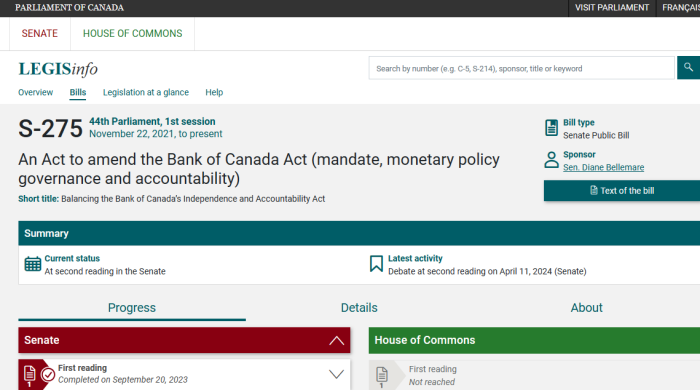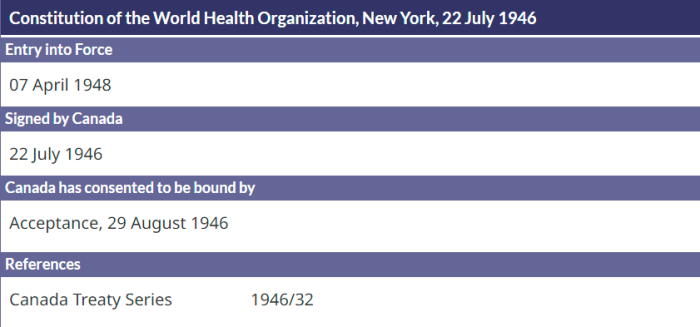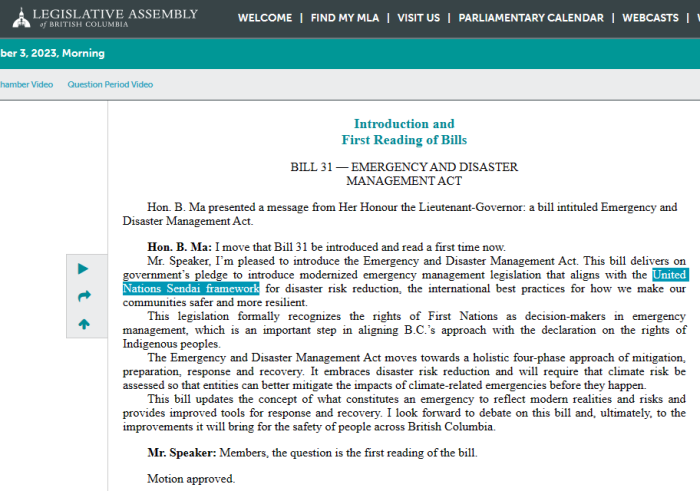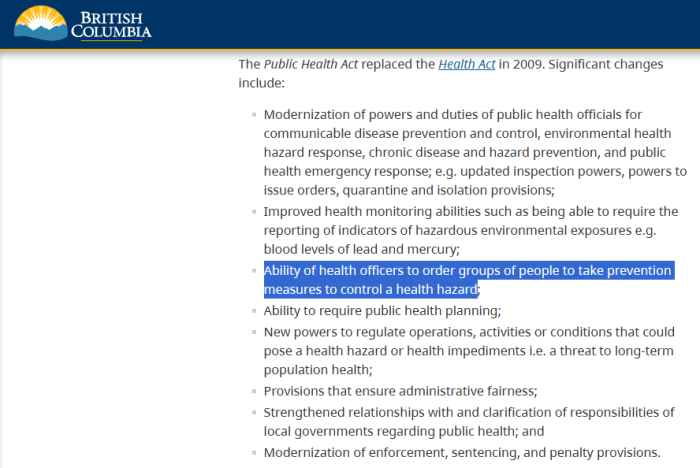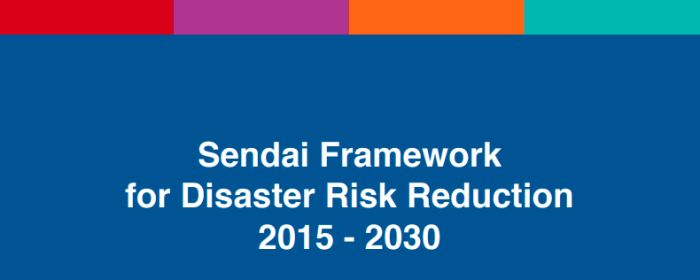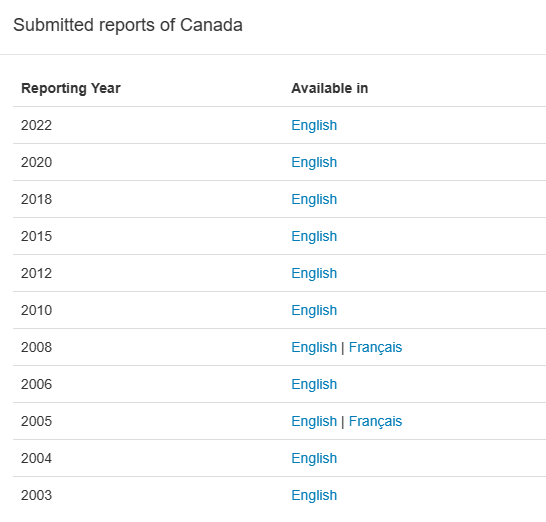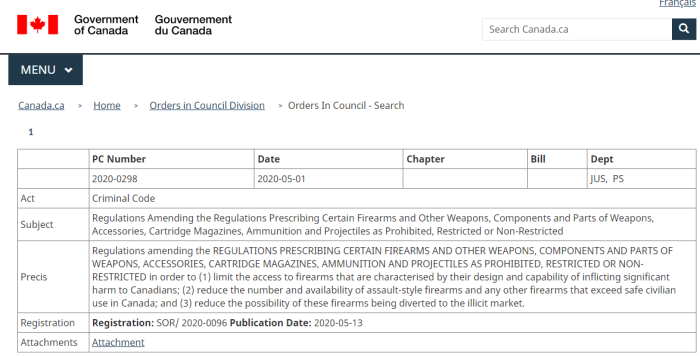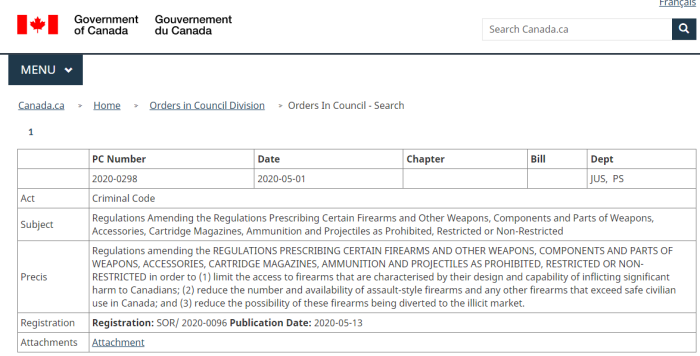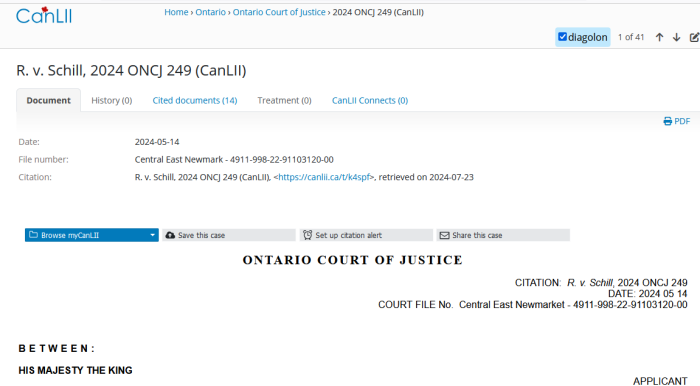
A few months ago, an Ontario Court Judge suspended the firearms permit of a man deemed to be a threat to the public. This came despite him being convicted of no crime. Gary Schill is prohibited from owning any firearm, cross-bow, prohibited weapon, restricted weapon, prohibited device, ammunition, prohibited ammunition or explosive substance for 5 years.
The reasoning of Justice Robinson rested largely — though not entirely — on his association with the “meme” group Diagolon, and its leader, Jeremy MacKenzie. The testimony itself as available in the transcripts linked below.
As an aside, yes, his name is misspelled throughout the ruling.
Part 2 of the series will focus on the testimony that was used.
For some background, Schill was arrested back in April 2022, along with his then-wife, Jennifer McNeil. Both faced domestic violence charges, but with his being the more serious. Charges against them were eventually dropped.
McNeil told the police that Schill: (a) was a member of Diagolon; (b) was a stream moderator; and (c) was recruiting ex-military members for the purpose of building a militia.
Following this, York Regional Police went to the Court for the purpose of pre-emptively getting a firearms prohibition against Schill. This came despite the fact that the charge against him had been dropped.
It’s worth noting that it’s not alleged that Schill ever engaged in any terrorist behaviour, or committed any ideologically motivated violence. However, the Judge thought that there were valid concerns that he might endanger the public.
This will probably come as a surprise to Diagolon supporters, who seem to be under the mistaken belief that the group was supposedly cleared with the “HateGate” revelations. Diagolon, after all, was based on a joke of a new country made up of the “sane” Provinces and States, going from Alaska to Florida.
But no such exoneration ever happened.
Paul S. Rouleau, head of Public Emergency Order Commission (PEOC) made it clear he views the group as a militia-like network. Members of CSIS, the RCMP and OPP all testified about their concerns.
There’s also the false claim going around that panic over this “meme country” was responsible for having the state of emergency declared in the first place. That also isn’t true. While MacKenzie and Diagolon were cited as concerns, there was a lot more going on.
Anyhow, more on that in a later piece. As for Schill:
[5] The entirety of the Crown’s case came through the evidence of D.C. Carmichael, a police officer with York Regional Police’s Tactical Intelligence Unit, a unit tasked with investigating terrorism, extremism and subversive groups.
Diagolon, Jeremy McKenzie and Mr. Schill.
[6] In August 2021, the police received a complaint from a member of the public regarding a police officer who was publicly associated with Jeremy McKenzie, a well-known extremist.
[7] Initially, D.C. Carmichael was tasked with conducting a surface level assessment of Mr. McKenzie. He quickly learned that Mr. McKenzie was a prominent podcaster under the name “Raging Dissident” with a large following. His views were vehemently anti-government and anti-authority. Mr. McKenzie was the founder and face of an organization named Diagolon.
[8] D.C. Carmichael identified two Diagolon-related Telegram channels in York region. One was entitled the “North of 7 Community Safe Zone for C-19 Bigots”. The other was “York Region Bigots”, which later became “York Region Purebloods.” D.C. Carmichael was able to join the channels and monitor their activity for approximately two years.
[9] The two York region channels directly referenced Diagolon. Whenever Jeremy McKenzie posted anything or released a podcast, its contents would be shared immediately on the York-region Telegram channels.
[10] The content of the channels was anti-vaccine, anti-government, white nationalist and white supremacy rhetoric. It involved conspiracy theory discussions and talk about assembly a militia by acquiring weaponry and body armour and planning meet-ups.
[11] D.C. Carmichael identified Mr. Schill early on as an active member on the Telegram channels. Unlike others who hid behind aliases, Mr. Schill identified himself by his real name and real photograph.
[12] Mr. McKenzie, the founder of Diagolon, actively promoted “Day of the Rope”, a book about a white supremacist revolution that was based on “The Turner Diaries”, a 1978 neo-nazi novel. The books, described by D.C. Carmichael as the bible of white nationalism, recount a race war that evolves into genocide in which all non-whites, Jews and “race traitors” are lynched.
[13] D.C. Carmichael observed nazi imagery on many of the profile pictures of Diagolon members on Telegram. Their discussions included coordinating meet-ups to engage in shooting and combat-training.
[14] A photograph of one such meet-up [exhibit 1] shows a gathering of 14 individuals performing a Diagolon “salute”. Mr. Schill can be seen saluting under a large Diagolon flag.
[15] As of 28 March 2024, D.C. Carmichael was able to determine through a social media query that Mr. Schill was still following Jeremy McKenzie on Instagram.
[16] There was also evidence that Mr. Schill was in communication with Paolo Scarpelli, a close associate of Jeremy McKenzie’s, to organize Diagolon dinner parties at Mr. Schill’s residence.
Conversations from Telegram were entered into evidence to try to demonstrate that these were not just words, but that Schill (and others) intended to meet up.
According to D.C. Ernest Carmichael, he had been monitoring various Telegram chats for approximately 2 years. This wasn’t anonymous gossip from the Canadian Antihate Network. It was the police actively monitoring group chats. These were used as exhibits.
Not only are the police watching the postings, but they’re checking to see who’s following who. It’s one way to build a “network of association”.
Telegram Chats Going Into Evidence
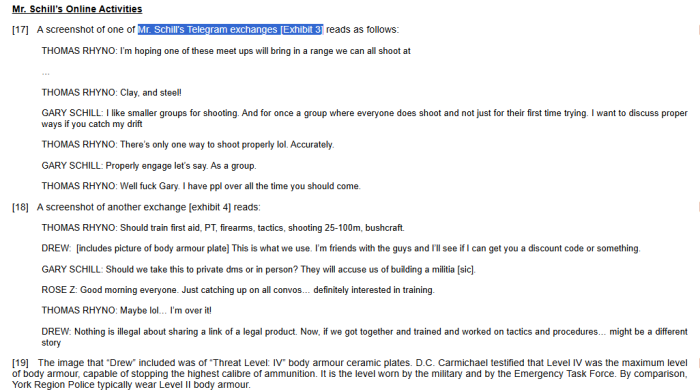
Posting pictures of guns, ammunition or body armour with the caption “let’s meet up” is a pretty idiotic thing to do. Considering the various topics that are discussed, it’s hard to imagine that it wouldn’t be used to try to incriminate people.
Asking to “take everything to DMs” or direct messages was used by the police to imply that this was intended for illegal purposes. Now, it may all have been perfectly legal and legitimate, but it was used as evidence that it wasn’t.
It’s quite stunning what people post. And the police were able to record everything, without ever needing a warrant.
The Judge also referenced the Coutts blockade, and the arrest of Chris Lysak, whom had been referred to as the “head of security of Diagolon”.
Publishing Evidence On MacKenzie’s Substack
[27] Shortly after Mr. Schill received his disclosure on the domestic charges, excerpts from it were posted on Jeremy McKenzie’s blog on Substack, an online platform.
This is mind-bogglingly stupid. Schill, at the time, was facing a charge of assault causing bodily harm. If the Crown had proceeded by indictment (the more serious option) a conviction even for a first offence would have been serious. It would mean a mandatory 10 year ban on all non-restricted weapons, and a lifetime ban on any restricted or prohibited weapons.
This is, of course, in addition to any jail time, probation or fine that was handed down.
Sharing with someone privately is one thing. But what would cause a person to think that publishing evidence in an open criminal case (with violence alleged) was a good idea?
Quoting The PEOC Report
Report of the Public Inquiry into the 2022 Public Order Emergency
[39] In February 2023, a report was released by the Honourable Paul S. Rouleau, Commissioner of a public Inquiry into the declaration of a Public Order Emergency issued by the federal government in 2022.
[40] The Report noted that “[l]aw enforcement and intelligence agencies view Diagolon as a militia-like extremist organization.”
[41] The Report further found that:
Diagolon may have started as a joke on Mr. McKenzie’s podcast, but it has grown into a larger community. The Royal Canadian Mounted Police (RCMP) has described Diagolon as a militia-like network with members who are armed and prepared for violence. In his testimony, the head of the Ontario Provincial Police (OPP) Intelligence Bureau described Diagolon as an extremist group… I am satisfied that law enforcement’s concern about Diagolon is genuine and well founded. The fact that a ballistic vest that was seized by the RCMP during the protests in Coutts – along with numerous guns – bore a Diagolon patch suggests as much.
[42] Notwithstanding the findings of the Commission, Mr. Foy points out that Diagolon is not currently listed as a terrorist entity on Public Safety Canada’s list of domestic terrorist groups.
Worth noting: Diagolon is not currently listed as a terrorist group.
Now, one could argue that it was unfair to have the PEOC Report used as a foundation for Justice Robinson here. Sure, it could be viewed as guilt by association. That being said, PEOC was used as a basis to pull Schill’s gun licence.
Assessment Of Risk Of Diagolon, Schill, MacKenzie
[64] The views of Jeremy McKenzie and his creation, Diagolon, can properly be described as anti-government and anti-authority, promoting the assembly of a militia to overthrow or, at the very least, actively resist the government.
[65] Mr. Pearson invites me to make a finding that Diagolon is a “terrorist group” as defined in s.83.01 C.C.. It is unnecessary for me to do so.
[66] Rather, it is sufficient – and permissible – for me to rely on the Commission Report’s findings that Diagolon is a militia-like extremist organization consisting of members who are armed and prepared for violence. I concur with the Commission’s finding that law enforcement’s concern about Diagolon is genuine and well-founded.
[67] Apart from the Commission’s findings, the evidence before me reasonably supports a valid public safety concern about the activities and members of Diagolon.
[68] Viewed cumulatively, there is cogent evidence that situates Mr. Schill in the inner ideological circle of Diagolon and close to its founder, Jeremy McKenzie. There is also cogent evidence of Mr. Schill’s intention to engage in the type of illegal activity espoused by Diagolon. For example:
(a) Mr. Schill’s devices show direct communication between him and Mr. McKenzie;
(b) Mr. Schill remains a follower of Mr. McKenzie on Instagram;
(c) Mr. Schill was an active participant on Telegram’s Diagolon channels based in York Region;
(d) Mr. Schill was observed in attendance at a Diagolon meet-up, where he was photographed giving the Diagolon salute under the Diagolon flag;
(e) Mr. Schill was actively engaged in organizing Diagolon meetings with Paolo Scarpelli, a close associate of Jeremy McKenzie;
(f) Mr. Schill’s wife provided evidence that he was attempting to recruit ex-military members to build a militia;
(g) Mr. Schill’s Telegram posts can reasonably be interpreted as an attempt to organize tactical shooting and combat training outings;
(h) Mr. Schill’s posts about attempting to acquire Level IV body armour and his desire to be “protected against mil spec” suggests active resistance against the government and not merely protection;
(i) Mr. Schill’s use of guarded language (e.g. “catch my drift” ) seems to confirm the illegal objective of the posts;
(j) Mr. Schill’s post about the House of Commons is clearly a reference to burning down Parliament;
(k) Mr. Schill was part of the inner circle Diagolon meeting on the outskirts of Ottawa during the Freedom Convoy;
(l)At the meeting, in which Jeremy McKenzie personally acknowledged and thanked Mr. Schill, Mr. McKenzie’s parting words were “there will not be any fucking surrendering as long as I am around;”
(m) Mr. Schill’s garage contained a re-load station in which he stored “huge amounts” of ammunition, not all of which was compatible with his lawfully-owned firearms; and
(n) In that same re-load station, Mr. Schill had a hand-drawn sketch of what can only be interpreted as a plan to engage in criminal activity at a closed gas station.
This was enough for Justice Robinson to conclude that a 5 year prohibition from weapons was warranted. For all the cries about this group just being a podcast community and “based on a meme”, these conversations and meets were used as evidence.
This ruling came from an Ontario Judge, not some nobody. Now, it’s precedent, and will almost certainly be cited in future cases.
Diagolon and MacKenzie weren’t cleared by the PEOC report. Rouleau made it clear that the thought the group was dangerous.
They weren’t cleared by the Mosley ruling either. That was the January 2024 verdict in Federal Court that it was unreasonable to invoke the Emergencies Act. There was just passing mention of them at all.
Defenders have claimed that there was no evidence of wrongdoing, and that there was a heavy reliance on groups like the Canadian Antihate Network. This was supposed to be some major intelligence failure. But Carmichael testified that he personally had been monitoring the chats for 2 years. The transcripts are available, and are also worth a read.
Now, a person has had his firearms rights suspended — despite not being convicted of a crime — due in large part to his connection to this “meme” group.
Could the police be lying or exaggerating in order to punish someone they ideologically disagree with? Sure, it’s possible. Nonetheless they were successful at getting the licence taken away. Please read the decision in full.
Guess that wasn’t something to brag about on the “Road Rage Terror Tour”.
More on PEOC and Mosley coming in subsequent posts.
Now, the ruling does look really, REALLY bad, but what was actually said at the hearing? The transcripts are available, so Carmichael’s testimony can be looked at. And interestingly, it comes across as a lot more speculative than what the Judge wrote. Stay tuned.
SCHILL HEARING:
(1) https://www.canlii.org/en/on/oncj/doc/2024/2024oncj249/2024oncj249.html
(2) Evidence Of Officer Ernest Carmichael, Day 1
(3) Evidence Of Officer Ernest Carmichael, Day 2, Cross Examination
PEOC HEARINGS:
(1) https://publicorderemergencycommission.ca/
(2) PEOC Report, Volume 1: Overview
(3) Public Order Emergency Report Volume 1 Overview
(4) PEOC Report, Volume 2: Analysis (Part 1)
(5) Public Order Emergency Report Volume 2 Analysis Part 1
(6) PEOC Report, Volume 3: Analysis (Part 2)
(7) Public Order Emergency Report Volume 3 Analysis Part 2 Recommendations
(8) PEOC Report, Volume 4: Process and Appendices
(9) Public Order Emergency Report Volume 4 Process And Appendices
(10) PEOC Report, Part 5: Policy Papers
(11) Public Order Emergency Report Volume 5 Policy Papers
MOSLEY DECISION:
(1) https://www.canlii.org/en/ca/fct/doc/2024/2024fc42/2024fc42.html#par41

